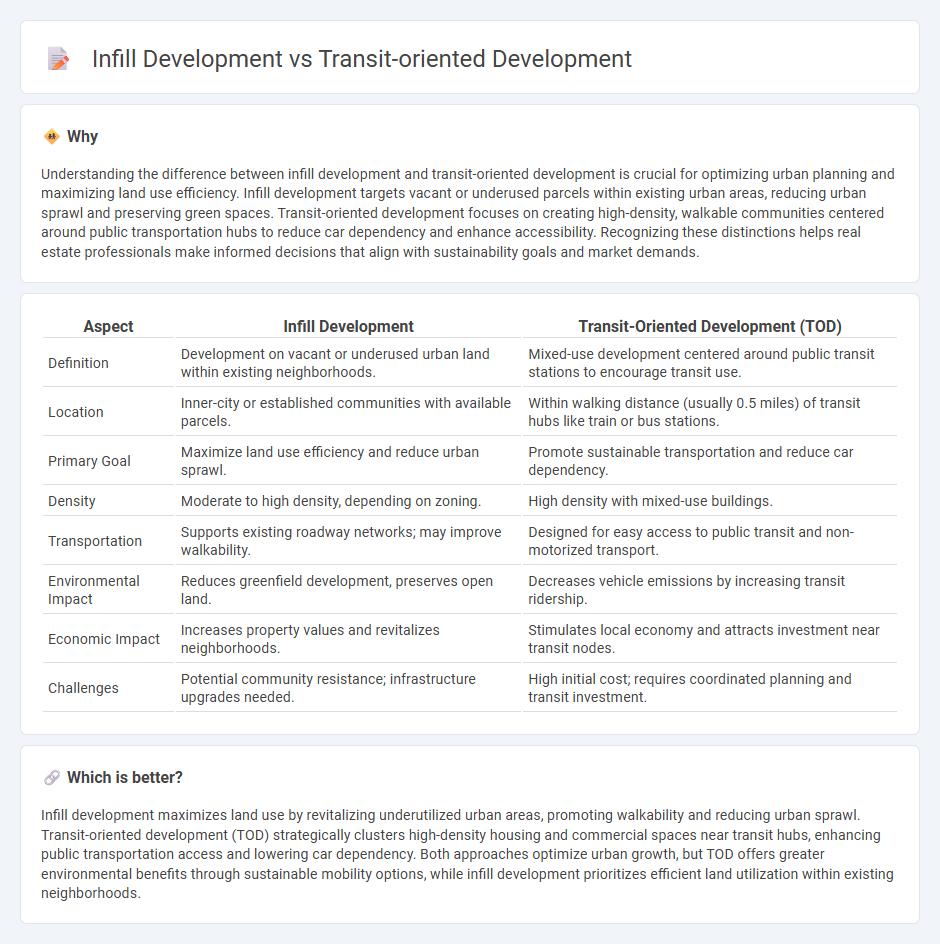
Infill development maximizes underutilized urban land by integrating residential and commercial projects within existing neighborhoods, enhancing density and reducing urban sprawl. Transit-oriented development (TOD) focuses on creating walkable communities centered around public transit hubs, promoting sustainable mobility and reducing reliance on cars. Discover how these strategic real estate approaches can transform urban living and investment opportunities.
Why it is important
Understanding the difference between infill development and transit-oriented development is crucial for optimizing urban planning and maximizing land use efficiency. Infill development targets vacant or underused parcels within existing urban areas, reducing urban sprawl and preserving green spaces. Transit-oriented development focuses on creating high-density, walkable communities centered around public transportation hubs to reduce car dependency and enhance accessibility. Recognizing these distinctions helps real estate professionals make informed decisions that align with sustainability goals and market demands.
Comparison Table
| Aspect | Infill Development | Transit-Oriented Development (TOD) |
|---|---|---|
| Definition | Development on vacant or underused urban land within existing neighborhoods. | Mixed-use development centered around public transit stations to encourage transit use. |
| Location | Inner-city or established communities with available parcels. | Within walking distance (usually 0.5 miles) of transit hubs like train or bus stations. |
| Primary Goal | Maximize land use efficiency and reduce urban sprawl. | Promote sustainable transportation and reduce car dependency. |
| Density | Moderate to high density, depending on zoning. | High density with mixed-use buildings. |
| Transportation | Supports existing roadway networks; may improve walkability. | Designed for easy access to public transit and non-motorized transport. |
| Environmental Impact | Reduces greenfield development, preserves open land. | Decreases vehicle emissions by increasing transit ridership. |
| Economic Impact | Increases property values and revitalizes neighborhoods. | Stimulates local economy and attracts investment near transit nodes. |
| Challenges | Potential community resistance; infrastructure upgrades needed. | High initial cost; requires coordinated planning and transit investment. |
Which is better?
Infill development maximizes land use by revitalizing underutilized urban areas, promoting walkability and reducing urban sprawl. Transit-oriented development (TOD) strategically clusters high-density housing and commercial spaces near transit hubs, enhancing public transportation access and lowering car dependency. Both approaches optimize urban growth, but TOD offers greater environmental benefits through sustainable mobility options, while infill development prioritizes efficient land utilization within existing neighborhoods.
Connection
Infill development and transit-oriented development (TOD) are connected through their shared focus on maximizing urban space efficiency and reducing reliance on automobiles. Infill development promotes building within existing urban areas, while TOD concentrates growth around public transit hubs to enhance accessibility and sustainable living. Together, these strategies support higher density, mixed-use neighborhoods that encourage walkability and minimize urban sprawl.
Key Terms
**Transit-Oriented Development:**
Transit-oriented development (TOD) prioritizes creating walkable, mixed-use communities centered around high-quality public transportation hubs, enhancing access and reducing car dependency. This urban planning strategy promotes higher density housing, retail, and office spaces within a half-mile radius of transit stations to optimize land use and support sustainable mobility. Explore how TOD transforms cities by fostering vibrant, connected neighborhoods with improved social, economic, and environmental outcomes.
Mixed-Use
Transit-oriented development (TOD) prioritizes the creation of mixed-use spaces centered around public transportation hubs to reduce car dependency and enhance walkability. Infill development focuses on utilizing underused urban land to introduce mixed-use buildings that blend residential, commercial, and recreational spaces within existing neighborhoods. Explore how integrating these strategies can optimize urban growth and sustainability.
Density
Transit-oriented development (TOD) prioritizes high-density, mixed-use projects centered around public transit hubs to maximize accessibility and reduce car dependence, fostering sustainable urban growth. Infill development focuses on increasing density within existing urban areas by utilizing underused or vacant land, enhancing neighborhood vibrancy without expanding city boundaries. Explore the benefits and strategies of TOD and infill development to optimize urban density effectively.
Source and External Links
Transforming the Urban Space Through Transit-Oriented Development - This webpage discusses how transit-oriented development (TOD) integrates urban planning with transportation systems to create more efficient and livable cities.
Transit-Oriented Development | FTA - This page provides an overview of TOD and its benefits, including neighborhood revitalization and increased affordability in housing.
Transit-Oriented Development - This webpage explains how TOD maximizes residential, commercial, and activity spaces near public transportation, promoting compact and walkable communities.
 dowidth.com
dowidth.com